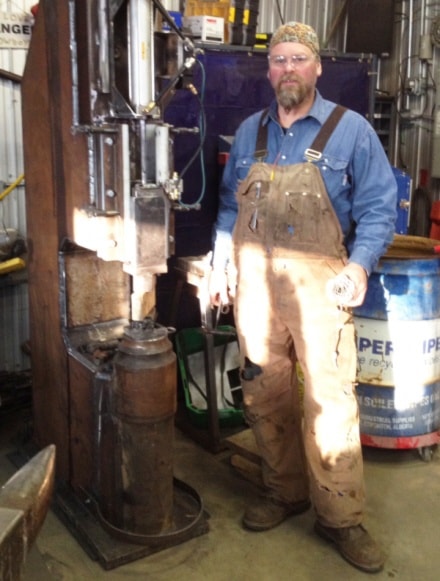By Don Ahlquist
Special to Rimbey Review
-38°C according to the outside thermometer. The furnace in the shop was not running and yet the shop inside was +22°C. The source of the heat was a propane forge blasting away at about +1370°C in the centre of the shop.
A giant pneumatic triphammer (that the blacksmith built and named Thor ) with a 90 pound head slammed into a 10 pound bar of semi-molten steel resting on the hammers bottom die. At every impact, a shower of sparks and red hot mill scale was ejected from the work piece. It sounded like a small cannon firing at a rate of about 200 detonations per minute.
A bar of steel was on deck and glowing bright orange inside the fire-brick lined walls of the forge. A steel rod about the diameter of a man's thumb was welded to the perimeter of the forge and held about 20 sets of tongs. Each tong was designed by the blacksmith to grasp and maintain control of one of a wide variety of shapes and sizes of steel pieces undergoing the forging processes.
This visit was very nostalgic for me. Sights, smells, sounds and even the tactile senses inspired a rich recall of childhood memories from my grandfather's blacksmith shop.
They say the most sophisticated method of commerce is barter and though very rare today, I can still remember my grandfather working on an agricultural implement in exchange for two chickens and a ham or some other equitable trade.
Tim Turnbull is the proprietor and artisan of the "SIK-WERKS" the facility we are visiting today. The shop is located on the west side of Gull Lake near Our Lady of Victory Church Camp.
Tim earns his living as an oilfield welder, working on drilling rigs, compressor stations, pipelines, etc. Consequently he is free to express himself creatively in blacksmithing without having to rely on it as a source of income.
During our visit, Tim provided us with some historic insight. Approximately 5200 years ago at the end of the Stone Age, the Bronze Age began. Bronze tools and weapons served the development of Mediterranean and European civilization and eventually escorted industry into the Iron Age at approximately 1400 to 1100 BC when the trade of Blacksmith (Dictionary defined as "a person who makes and repairs things in iron by hand") essentially began. The terms "In iron" and "buy hand" define the unique nature of blacksmithing. Each and every piece ever made with blacksmithing tools is unique. A term often confused with blacksmithing is foundering which is pouring or casting molten metal for repetitive production and is not, in the purest sense, blacksmithing. Foundering is a process whereas blacksmithing is an art and like all art, it is absolutely impossible to duplicate the original.
The customer approaches the blacksmith with an idea of what they want. The blacksmith usually offers insight and advice to the customer and the product of their combined imagination is turned into reality.
Prices vary but if the blacksmith has any talent and reputation at all they are always higher than what is paid at a retail outlet for an article that hundreds or even thousands of other people own, has no genuine artistic worth and is often of inferior quality.
Because of the sophistication and efficiency of other trades such as welding and machining, the industrial reliance on the blacksmith's trade has diminished considerably over time but its artistic character has flourished.
Tim states that over the last 10 to 15 years he has seen tremendous resurgence in blacksmithing. Courses are offered at institutions in a variety of blacksmith disciplines such as knife making, Damascus processing, antique tool and equipment restoration and ornamental blacksmithing.
There are a lot of talented people in our neck of the woods, says Tim, adding some don't realize they are in possession of that talent. All they need is some tangible way of developing their basic interest, he says.
Tim encourages anyone even remotely interested in the art and science of blacksmithing to give him a call at 403-302-8685 and he will do his best to direct their interest in this productive and immensely satisfying avenue of expression.
